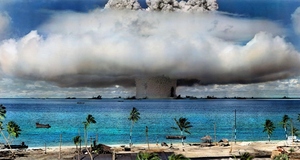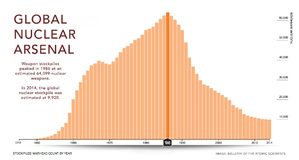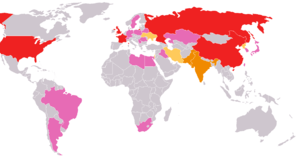From Cornell International Affairs Review VOL. 7 NO. 2U.S. Policy of Engagement Toward North Korea: Normalizing the Balance of TerrorStrategy for DenuclearizationThe critical questions to ask are: Would engagement be enough to build trust? Would North Korea trust US declarations towards normalization and transparency? What makes engagement credible in regards to both the benefits of cooperation and the consequences of belligerence? The success and credibility of the engagement approach hinges critically on regional integration and cooperation at the security and economic level that remains largely absent in Asia. Up until the recent decade, the United States has pursued a post- World War II “hub-and-spokes” model in East Asia that consists of individual bilateral ties with Asian nations over regional network of multilateral ties and institutions. This “huband- spokes” model dampens the drive to build a regional network of multilateral ties by (1) creating bilateral security and economic ties with South Korea and Japan that intentionally serve as a balancing strategy against China’s rise and regional hegemonic aspirations and (2) creating few institutional means or political necessity to resolve the historical memory of Japanese colonialism that remains raw in the national psyche of Asian nations - particularly those of South Korea and China - and continues to deepen hostilities and mistrust in the region. Denuclearization of the Korean peninsula rests on cohesive action under regional multilateralism that hinges upon East Asian cooperation. The consequent lack of regional cohesion in security, political, and economic multilateral ties significantly undermines the US leverage in a hypothetical engagement approach as North Korea can reliably turn to its regional neighbors, particularly China, in the event of failed unilateral negotiations and agreements with the United States. Denuclearizing North Korea ultimately rests on resolving the historical tensions between various nations in East Asia, establishing cooperation at the regional level that lays the foundation for a cohesive multilateral action, and securing a regional multilateral policy towards North Korea that aligns with a US policy of engagement. This would not only strengthen the US strategic and diplomatic leverage in North Korea but also heighten the sense of guarantee that the US would follow through on its actions as a result of deep multilateral networks in the region. Essentially, US leverage in North Korea can only be made real by creating regional leverage over North Korea. The 1994 agreed framework largely failed as a result of failures of both the United States and North Korea to follow through on the steps of the agreements in lieu of growing mistrust of each other’s intentions. The United States largely acted on the assumption that North Korea will collapse upon the death of its leader Kim Jong Il. North Korea in turn doubted the intentions behind the United States’ sudden turn in foreign policy as well as the lack of guarantees that it would meet its end of the bilateral agreement in the absence of international action or backing. Denuclearization of the Korean peninsula rests on cohesive action under regional multilateralism that hinges upon East Asian cooperation. The linchpin to this cooperation is China, which has exercised extensive political, economic, and diplomatic influence on North Korea and remains its last regional “ally.” Deepening security and economic links between China, South Korea, and Japan will either further isolate North Korea as China establishes ties with its other neighbors or in the more unlikely scenario, bridge South Korea and Japan to North Korea through ties with China. In either possibilities, deepening regional ties between North Korea’s neighbors narrows North Korea’s foreign policy options towards cooperation as the traditional hostilities that it had once manipulated and utilized as leverage in regional and international affairs become rendered effectively useless. Moreover, as a new Asian political and economic region emerges, North Korea faces the option of either hopping on the wagon of an increasingly powerful region – perhaps in the future, another European Union or North Atlantic Trade Organization – or incurring the wrath of a regionally cohesive Asia. Already, the South Korean government has initiated what the current Park administration calls “trustpolitik strategy” for improving and stabilizing relations with its closest neighbors - North Korea, China, and Japan. Such strategy involves “laying the groundwork for the reduction of tension and peaceful coexistence on the Korean peninsula” through 1) strong US-Korea alliance 2) trilateral cooperation between Korea, US, and Japan 3) development of close ties of cooperation and partnership with China and Russia and 4) enhancing cooperation with Europe and ASEAN nations and 5) “continuing efforts to persuade North Korea to comply with its nuclear nonproliferation obligations through inter-Korean dialogue channels.”23 The Park administration has realistically “proposed greater cooperation on ‘softer issues’” of the environment, nuclear safety, and disaster relief as the first step to establishing trust, which would enable greater trilateral cooperation in addressing the more complex political, economic, and social issues. Since this proposal was first announced, the talks on the China-ROK-Japan Free Trade Agreement has been initiated and trilateral “dialogue and cooperation on issues such as the environment, culture, nuclear safety and cyber security” have made significant headway even as political relations deteriorate.24 The foreign policy approach of the United States in addressing a nuclear North Korea then, should involve laying the foundations for a regionally cohesive Asia. The United States must recognize China’s rise and its place as the regional power as both inevitable and acceptable, and cut back on bilateral agreements with South Korea and Japan, allowing the region’s major powers to forge cooperative security and economic ties that were largely discouraged by bilateral ties with the United States. Paradoxically, the United States must take a step back from its roles as a hegemonic power in Asia and a balancing force against China in the region in order to foster regional cooperation necessary for the denuclearization of the Korean peninsula. While some may argue that this policy recommendation fundamentally suggests that the United States sacrifice its leverage in Asia for leverage in North Korea, the reality is that increasing challenges to US hegemony and reductions in its leverage in Asia is inevitable as China and the region as a whole “rises.” From several paradigmatic viewpoints, we ask: Is the United States willing to voluntarily reduce its influence and power in the region? Will it allow for regional alignment economically and politically? Does it value international peace and cooperation over regional power and interests? But realistically, the United States cannot stop the inevitable rise of regional multilateralism and cooperation in Asia. While achieving regional cohesion inevitably reduces the US leverage in Asia in the short-term, it would secure the continued existence of that very leverage in the future if the United States spearheads the movement for multilateral cooperation and peace today. The essential question to ask then is: “Will the United States lead the charge for regional cohesion and thereby secure and sustain its leverage? Or will it resist the inevitable and continue to proliferate means for continued North Korean nuclear weapons development while also risking its place at the Asian table in the future? ConclusionNorth Korea remains the last vestige of the Cold War era of nuclear power balancing, which has shown itself to be unsustainable and detrimental to international peace and cooperation. The policies of isolation and containment have been tried by past administrations but have ultimately failed to deter further proliferation of weapons in North Korea due to their failure to ensure multilateral action and recognize North Korea’s security dilemma. A foreign policy approach of integrative engagement, however, extends conditional diplomatic and economic benefits over immediate denuclearization. Engagement serves as a method of gradually integrating North Korea into the international economy and institutional norms that advances transparency, creates leverage to shape North Korean behavior, and eventually end the balance of terror on the Korean peninsula. But this denuclearization hinges upon the United States’ willingness to lead the creation of a cohesive regional force in Asia, which would inevitably challenge its influence and power in the region in the short-run. Endnotes
Suggested Reading from Inquiries Journal
Inquiries Journal provides undergraduate and graduate students around the world a platform for the wide dissemination of academic work over a range of core disciplines. Representing the work of students from hundreds of institutions around the globe, Inquiries Journal's large database of academic articles is completely free. Learn more | Blog | Submit Latest in Political Science |



















